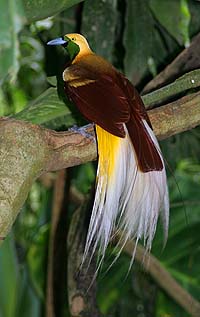 On Wednesday 2nd November I attended the Darwin Lecture 2011, an annual lecture jointly organised by the Society of Medicine and the Linnean Society. The Lecture, held at the Royal Society of Medicine was given by Sir David Attenborough and was entitled 'Alfred Russel Wallace and the Birds of Paradise'. I was extremely pleased to see that two lecture theatres (one with a video link to the main lecture theatre) were full and that the majority of people in attendance were not Fellows of either Society, but were in fact members of the public. Whilst I would attribute this popularity to the fact that Sir David himself was delivering the lecture, I was still extremely happy to think that so many people would be hearing about Wallace and the time he spent as a collector of natural history specimens in the tropics during the 1840s and 1850s.
On Wednesday 2nd November I attended the Darwin Lecture 2011, an annual lecture jointly organised by the Society of Medicine and the Linnean Society. The Lecture, held at the Royal Society of Medicine was given by Sir David Attenborough and was entitled 'Alfred Russel Wallace and the Birds of Paradise'. I was extremely pleased to see that two lecture theatres (one with a video link to the main lecture theatre) were full and that the majority of people in attendance were not Fellows of either Society, but were in fact members of the public. Whilst I would attribute this popularity to the fact that Sir David himself was delivering the lecture, I was still extremely happy to think that so many people would be hearing about Wallace and the time he spent as a collector of natural history specimens in the tropics during the 1840s and 1850s.
The lecture was excellent, as Sir David not only focused on the Birds of Paradise, but he also gave a fascinating overview of Wallace as a naturalist, covering topics such as his time spent in the Amazon with Henry Walter Bates (1848-1852) and in the Malay Archipelago (1854-1862); which is where he discovered new species of paradise birds, independently conceived the theory of evolution by natural selection in February 1858, and proposed the 'Wallace Line'. Most importantly, however, I think Sir David did an excellent job of emphasising how important Wallace's contributions to natural history are and just what an extraordinary man he was!
Sir David had several video clips to show throughout the lecture of the courtship displays of several paradise birds, which were fascinating to watch and also highlighted how special it must have been for Wallace to have been one of the first naturalists to have witnessed these beautiful creatures in their natural habitat. There are 42 species of Birds of Paradise, which are members of the Paradisaeidae family. The majority of the species are found on the island of New Guinea, with some occurring in the Moluccas and Eastern Australia. The birds are best known for the beautiful plumage and elaborate feathers of the males, which extend from their wings, beak or head and are designed to help them win a mate. An interesting question was put to Sir David asking about the threat of extinction to these birds, to which he answered that the birds are relatively well protected in their habitats by the native populations that there is, thankfully, no real immediate threat to their survival.
I recently catalogued a letter by Wallace, written on 16th February 1862 to Samuel Stevens (Wallace's agent in London who sold his natural history specimens) in which he informed Stevens that he had purchased two New Guinean Lesser Birds of Paradise in Singapore and was hoping to bring them back to England, "if they pass the ordeal of the dry atmosphere of the Red Sea and Egypt". Tantalisingly, I don't yet know whether the paradise birds made it to England safely or not, but I hope in the course of the project we'll find some letters that will complete the story!
-Caroline-
You are here
About Wallace
Online Catalogue of Letters
Resources
Wallace's copyright
Links to Other Sites
Who's online
There are currently 0 users online.


Add new comment